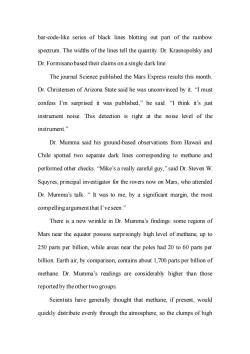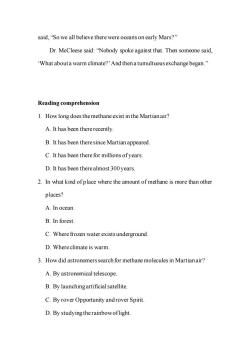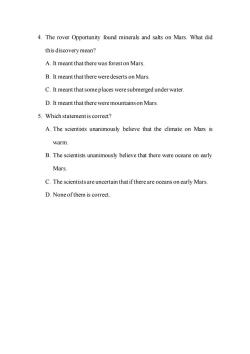私立华联学院:《英文报刊阅读》课程教学资源(练习题,十套)Methane in Martian Air Suggests Life Beneath the Surface科技报道_Methane in Martian Air Suggests Life Beneath the Surface

Methane in Martian Air Suggests Life Beneath the Surface A third team of scientists has now reported a seemingly simply discovery on Mars:its atmosphere contains methane. But that finding has potentially profound implications,including the possibility ofpresent-day microbes living on Mars. Speaking this month at the American Astronomical Society's Division for Planetary Sciences meeting in Louisville,Ky.,Dr.Michael Mumma,a senior scientist at NASA's Goddard Space Flight Center in Greenbelt,Md,reported three years of observations had provided strong evidence for methane. Methane,the simplest of hydrocarbon molecules with one carbon and four hydrogen atoms,is fragile in air and easily broken apart when hit by ultraviolet light.Calculations indicate that any methane in the Martian air must have been put there within the past 300 years. That then raises the question:What is putting methane into the Martianair? There seem to be only two plausible explanations.One is geothermal chemical reactions involving water and heat like those that occur on Earth in the hot springs of Yellowstone or at hydrothermal vents on the bottoms ofoceans
Methane in Martian Air Suggests Life Beneath the Surface A third team of scientists has now reported a seemingly simply discovery on Mars: its atmosphere contains methane. But that finding has potentially profound implications, including the possibility of present-day microbes living on Mars. Speaking this month at the American Astronomical Society’s Division for Planetary Sciences meeting in Louisville, Ky., Dr. Michael Mumma, a senior scientist at NASA’s Goddard Space Flight Center in Greenbelt, Md, reported three years of observations had provided strong evidence for methane. Methane, the simplest of hydrocarbon molecules with one carbon and four hydrogen atoms, is fragile in air and easily broken apart when hit by ultraviolet light. Calculations indicate that any methane in the Martian air must have been put there within the past 300 years. That then raises the question: What is putting methane into the Martian air? There seem to be only two plausible explanations. One is geothermal chemical reactions involving water and heat like those that occur on Earth in the hot springs of Yellowstone or at hydrothermal vents on the bottoms of oceans

That would intrigue planetary geologists.Although frozen water is known to exist,there are no signs that any volcanism has occurred there for millions of years.Also,an instrument aboard NASA's Mars Odyssey looked for warm spots on Mars'surfaceand did not find any The other,more intriguing,is life.On Earth,a class of bacteria known as methanogens breathes out methane as a waste product.The discovery,if confirmed,suggests that perhaps Martian life arose on a presumably more hospitable Mars billions of years ago and survives to this day underground,beneath the cold,dry landscape Others are more cautious."Three difficult detections,or marginal detections,don't equate to one really strong one,"said Dr.Philip R. Christensen,a professor of geological sciences at Arizona State University. In January,scientists working on the European Space Agency's Mars Express mission also reported the detection ofthe methane.A few months later,that group,led by Dr.Vittorio Formisano of the Institute of Physics and Interplanetary Science in Rome reported that the methane appeared to be more plentiful in regions where frozen water is known to exist underground. All three teams of astronomers looked for methane molecules in the Martian air by examining the rainbow of light reflected by the planet. Different molecules absorb different,very specific colors,producing a
That would intrigue planetary geologists. Although frozen water is known to exist, there are no signs that any volcanism has occurred there for millions of years. Also, an instrument aboard NASA’s Mars Odyssey looked for warm spots on Mars’surface and did not find any. The other, more intriguing, is life. On Earth, a class of bacteria known as methanogens breathes out methane as a waste product. The discovery, if confirmed, suggests that perhaps Martian life arose on a presumably more hospitable Mars billions of years ago and survives to this day underground, beneath the cold, dry landscape. Others are more cautious. “ Three difficult detections, or marginal detections, don’t equate to one really strong one,” said Dr. Philip R. Christensen, a professor of geological sciences at Arizona State University. In January, scientists working on the European Space Agency’s Mars Express mission also reported the detection of the methane. A few months later, that group, led by Dr. Vittorio Formisano of the Institute of Physics and Interplanetary Science in Rome reported that the methane appeared to be more plentiful in regions where frozen water is known to exist underground. All three teams of astronomers looked for methane molecules in the Martian air by examining the rainbow of light reflected by the planet. Different molecules absorb different, very specific colors, producing a

bar-code-like series of black lines blotting out part of the rainbow spectrum.The widths of the lines tell the quantity.Dr.Krasnopolsky and Dr.Formisano based their claims on a single dark line. The journal Science published the Mars Express results this month Dr.Christensen of Arizona State said he was unconvinced by it."I must confess I'm surprised it was published,"he said."I think it's just instrument noise.This detection is right at the noise level of the instrument.” Dr.Mumma said his ground-based observations from Hawaii and Chile spotted two separate dark lines corresponding to methane and performed other checks."Mike's a really careful guy,"said Dr.Steven W. Squyres,principal investigator for the rovers now on Mars,who attended Dr.Mumma's talk."It was to me,by a significant margin,the most compellingargument that I've seen." There is a new wrinkle in Dr.Mumma's findings:some regions of Mars near the equator possess surprisingly high level of methane,up to 250 parts per billion,while areas near the poles had 20 to 60 parts per billion.Earth air,by comparison,contains about 1,700 parts per billion of methane.Dr.Mumma's readings are considerably higher than those reported by the other two groups. Scientists have generally thought that methane,if present,would quickly distribute evenly through the atmosphere,so the clumps of high
bar-code-like series of black lines blotting out part of the rainbow spectrum. The widths of the lines tell the quantity. Dr. Krasnopolsky and Dr. Formisano based their claims on a single dark line. The journal Science published the Mars Express results this month. Dr. Christensen of Arizona State said he was unconvinced by it. “I must confess I’m surprised it was published,” he said. “I think it’s just instrument noise. This detection is right at the noise level of the instrument.” Dr. Mumma said his ground-based observations from Hawaii and Chile spotted two separate dark lines corresponding to methane and performed other checks. “Mike’s a really careful guy,” said Dr. Steven W. Squyres, principal investigator for the rovers now on Mars, who attended Dr. Mumma’s talk. “ It was to me, by a significant margin, the most compelling argument that I’ve seen.” There is a new wrinkle in Dr. Mumma’s findings: some regions of Mars near the equator possess surprisingly high level of methane, up to 250 parts per billion, while areas near the poles had 20 to 60 parts per billion. Earth air, by comparison, contains about 1,700 parts per billion of methane. Dr. Mumma’s readings are considerably higher than those reported by the other two groups. Scientists have generally thought that methane, if present, would quickly distribute evenly through the atmosphere, so the clumps of high

concentration suggest that not only are there sources emitting methane. but perhaps some process is also destroying methane over the poles. The methane findings on current-day Mars come as planetary scientists are again rethinking their ideas about long-ago Mars Geological carvings on the surface,from ones that look a tropical paradise,perhaps warmed by a thick heat-trapping blanket of carbon dioxide in its atmosphere. But climatologists found that it was hard for their computer models to provide that much warming,and scientists shifted to a picture of Mars as wet,but cold.Many of the features could have been cut by glaciers or transitory hellish deluges when ice was melted by meteor strikes. Mars also possesses few carbonates,the minerals in limestone tha would be expected to form in the presence of water,but does have much olivine,a mineral that falls apart when exposed to moisture. This year,however,the rover Opportunity,which landed at a site called Meridiani Planum,found minerals and salts that indicate that that part of Mars at least had once been soaked in water,although when and for how long remain uncertain.Dr.Squyres also noted that while the minerals indicate liquid water,"We see nothing that looks like wave ripples"in the layers of sediments preserved in the rocks. The other rover,Spirit,on the other side of Mars,initially found only volcanic rocks that appear almost unchanged for billions of years.It has
concentration suggest that not only are there sources emitting methane, but perhaps some process is also destroying methane over the poles. The methane findings on current-day Mars come as planetary scientists are again rethinking their ideas about long-ago Mars. Geological carvings on the surface, from ones that look a tropical paradise, perhaps warmed by a thick heat-trapping blanket of carbon dioxide in its atmosphere. But climatologists found that it was hard for their computer models to provide that much warming, and scientists shifted to a picture of Mars as wet, but cold. Many of the features could have been cut by glaciers or transitory hellish deluges when ice was melted by meteor strikes. Mars also possesses few carbonates, the minerals in limestone that would be expected to form in the presence of water, but does have much olivine, a mineral that falls apart when exposed to moisture. This year, however, the rover Opportunity, which landed at a site called Meridiani Planum, found minerals and salts that indicate that that part of Mars at least had once been soaked in water, although when and for how long remain uncertain. Dr. Squyres also noted that while the minerals indicate liquid water, “We see nothing that looks like wave ripples” in the layers of sediments preserved in the rocks. The other rover, Spirit, on the other side of Mars, initially found only volcanic rocks that appear almost unchanged for billions of years. It has

since rolled to nearby hills,which appear to be slightly older,where the rocks seem to have been significantly changed by water. The rover findings and others presented last month in Jackson Hole, Wyo.,at a conference about early Mars have led some to think again of the planet longago as warm and wet. Even Dr.James F.Kasting,a climatologist at Penn State whose models helped convince people that Mars had not been warm,has changed his mind.Dr.Kasting is now investigating methane,a more potent greenhouse gas than carbon dioxide,as a cause of warming.His initial simulations show methane cooling the planet but he thinks the error is in his calculations,not his hypothesis. "I think it's our problem,not Mars'problem,"he said."I think the evidence keeps mounting that it was warm.I think it has to be stably warm." The opinion is not unanimous,but the idea of early oceans is gaining favor.Some scientists,like Dr.Stephen M.Clifford of the Lunar and Planetary Institute in Houston,said that four billion years ago he decay of radioactive elements in the core of Mars would have produced enough heat to melt ice from below,producing an ice-covered ocean.Acidic waters could explain the lack of carbonates Dr.Daniel J.McCleese,chief scientist for Mars exploration at the NASA's Jet Propulsion Laboratory,said that during discussions someone
since rolled to nearby hills, which appear to be slightly older, where the rocks seem to have been significantly changed by water. The rover findings and others presented last month in Jackson Hole, Wyo., at a conference about early Mars have led some to think again of the planet long ago as warm and wet. Even Dr. James F. Kasting, a climatologist at Penn State whose models helped convince people that Mars had not been warm, has changed his mind. Dr. Kasting is now investigating methane, a more potent greenhouse gas than carbon dioxide, as a cause of warming. His initial simulations show methane cooling the planet but he thinks the error is in his calculations, not his hypothesis. “I think it’s our problem, not Mars’ problem,” he said. “I think the evidence keeps mounting that it was warm. I think it has to be stably warm.” The opinion is not unanimous, but the idea of early oceans is gaining favor. Some scientists, like Dr. Stephen M. Clifford of the Lunar and Planetary Institute in Houston, said that four billion years ago he decay of radioactive elements in the core of Mars would have produced enough heat to melt ice from below, producing an ice-covered ocean. Acidic waters could explain the lack of carbonates. Dr. Daniel J. McCleese, chief scientist for Mars exploration at the NASA’s Jet Propulsion Laboratory, said that during discussions someone

said,"So we all believe there were oceans on early Mars?" Dr.MeCleese said:"Nobody spoke against that.Then someone said, What about a warm climate?'And thena tumultuous exchange began." Reading comprehension 1.How long does the methane exist in the Martianair? A.It has been thererecently B.It has been there since Martian appeared C.It has been there for millions ofyears. D.It has been therealmost 300 years. 2.In what kind ofplace where the amount of methane is more than other places? A.In ocean B.In forest C.Where frozen water exists underground. D.Where climate is warm. 3.How did astronomerssearch for methane molecules in Martianair? A.By astronomicaltelescope. B.By launchingartificial satellite C.By rover Opportunity androver Spirit. D.By studyingtherainbowoflight
said, “So we all believe there were oceans on early Mars?” Dr. McCleese said: “Nobody spoke against that. Then someone said, ‘What about a warm climate?’And then a tumultuous exchange began.” Reading comprehension 1. How long does the methane exist in the Martian air? A. It has been there recently. B. It has been there since Martian appeared. C. It has been there for millions of years. D. It has been there almost 300 years. 2. In what kind of place where the amount of methane is more than other places? A. In ocean. B. In forest. C. Where frozen water exists underground. D. Where climate is warm. 3. How did astronomers search for methane molecules in Martian air? A. By astronomical telescope. B. By launching artificial satellite. C. By rover Opportunity and rover Spirit. D. By studying the rainbow of light

4.The rover Opportunity found minerals and salts on Mars.What did this discovery mean? A.It meant that there was foreston Mars. B.It meant thatthere were deserts on Mars C.It meant that some places were submerged under water. D.It meant that there were mountainson Mars. 5.Which statementis correct? A.The scientists unanimously believe that the climate on Mars is warm. B.The scientists unanimously believe that there were oceans on early Mars. C.The scientists are uncertain that ifthere are oceans on early Mars. D.None ofthem is correct
4. The rover Opportunity found minerals and salts on Mars. What did this discovery mean? A. It meant that there was forest on Mars. B. It meant that there were deserts on Mars. C. It meant that some places were submerged under water. D. It meant that there were mountains on Mars. 5. Which statement is correct? A. The scientists unanimously believe that the climate on Mars is warm. B. The scientists unanimously believe that there were oceans on early Mars. C. The scientists are uncertain that if there are oceans on early Mars. D. None of them is correct
按次数下载不扣除下载券;
注册用户24小时内重复下载只扣除一次;
顺序:VIP每日次数-->可用次数-->下载券;
- 私立华联学院:《英文报刊阅读》课程教学资源(练习题,十套)Is Heart Surgery Worth It医学报道_Is Heart Surgery Worth It.docx
- 私立华联学院:《英文报刊阅读》课程教学资源(练习题,十套)Investment Fever in Clean-Energy经济投资_Investment Fever in Clean.docx
- 私立华联学院:《英文报刊阅读》课程教学资源(练习题,十套)Environmental Protection 环境保护全球变暖_Global Warming Threatens Deserts.docx
- 私立华联学院:《英文报刊阅读》课程教学资源(练习题,十套)A World View Must Be Part of School Culture教育报道_A World View Must Be Part of School Culture.docx
- 私立华联学院:《英文报刊阅读》课程教学资源(练习题,十套)A Tale of Two Cultrues文化报道_A Tale of Two Cultures.docx
- 私立华联学院:《英文报刊阅读》课程教学资源(练习题,十套)练习题十套的参考答案.docx
- 私立华联学院:《英文报刊阅读》课程教学资源(试卷)英文报刊阅读考卷A(含答案).doc
- 私立华联学院:《英语精读》课程PPT教学课件(A New English Course)Unit 9 University Days.ppt
- 私立华联学院:《英语精读》课程PPT教学课件(A New English Course)Unit 8 A Friend in Need.ppt
- 私立华联学院:《英语精读》课程PPT教学课件(A New English Course)Unit 7 From Composer to Interpreter to Listener.ppt
- 私立华联学院:《英语精读》课程PPT教学课件(A New English Course)Unit 6 The Pearl.ppt
- 私立华联学院:《英语精读》课程PPT教学课件(A New English Course)Unit 5 Antarctica.ppt
- 私立华联学院:《英语精读》课程PPT教学课件(A New English Course)Unit 4 Network Desinger——-Tim Berners-Lee.ppt
- 私立华联学院:《英语精读》课程PPT教学课件(A New English Course)Unit 3 Writing between the lines.ppt
- 私立华联学院:《英语精读》课程PPT教学课件(A New English Course)Unit 2 Salvation.ppt
- 私立华联学院:《英语精读》课程PPT教学课件(A New English Course)Unit 12 After Twenty Years.ppt
- 私立华联学院:《英语精读》课程PPT教学课件(A New English Course)Unit 11 Neat People vs. Sloppy People.ppt
- 私立华联学院:《英语精读》课程PPT教学课件(A New English Course)Unit 10 Abducting the Cloning Debate.ppt
- 私立华联学院:《英语精读》课程PPT教学课件(A New English Course)Unit 1 Resolutions.ppt
- 私立华联学院:《英语精读》课程教学资源(试卷习题)新大学英语四级考试全真模拟考试(四)参考答案.doc
- 私立华联学院:《英文报刊阅读》课程教学资源(练习题,十套)Out of the Comfort Zone欧洲妇女面面观_Out of the Comfort Zone.docx
- 私立华联学院:《英文报刊阅读》课程教学资源(练习题,十套)The Gay-Marriage Flap; The Government Is out of Step with Public Opinion同性恋婚姻_The Gay-Marriage Flap; The Government Is out of Step with Public Opinion.docx
- 私立华联学院:《英文报刊阅读》课程教学资源(练习题,十套)Tragic End to Beslan Hostage Crisis恐怖主义_Tragic End to Beslan Hostage Crisis.docx
- 私立华联学院:《英文报刊阅读》课程教学资源(练习题,十套)Voice of Courage政治人物_Voice of Courage.docx
- 私立华联学院:《英文报刊阅读》课程教学资源(电子教案)Passage 1 Stay away from these(远离致命动物).doc
- 私立华联学院:《英文报刊阅读》课程教学资源(电子教案)Passage 10 Hong Kong's Occupy Central participants urged to reflect(香港‘占中’事件).doc
- 私立华联学院:《英文报刊阅读》课程教学资源(电子教案)Passage 11 Student calls for samesex marriage(中国大学生呼吁同性恋婚姻合法化).doc
- 私立华联学院:《英文报刊阅读》课程教学资源(电子教案)Passage 12 Death incites unrest(美国种族主义).doc
- 私立华联学院:《英文报刊阅读》课程教学资源(电子教案)Passage 13 Police seek motive in fatal Washington state school shooting(美国校园枪击案).doc
- 私立华联学院:《英文报刊阅读》课程教学资源(电子教案)Passage 14 Sitcoms mine the hardships of young adults worldwide(美剧《老友记》经典二十年).doc
- 私立华联学院:《英文报刊阅读》课程教学资源(电子教案)Passage 15 APEC promises to bring new prosperity(中国通过亚太经合组织会议承诺中国将带领各成员国共同发展繁荣).doc
- 私立华联学院:《英文报刊阅读》课程教学资源(电子教案)Passage 16 China Russia pledge to strengthen cooperation(中俄承诺加强合作).doc
- 私立华联学院:《英文报刊阅读》课程教学资源(电子教案)Passage 17 Travel agencies told to regulate tourist(中国将不文明旅客列入黑名单).doc
- 私立华联学院:《英文报刊阅读》课程教学资源(电子教案)Passage 2 Jackie Chan's son Jaycee faces being 'detained for six months'(名人吸毒).doc
- 私立华联学院:《英文报刊阅读》课程教学资源(电子教案)Passage 3 Klose calls it a day for Germany(德国国足克洛泽退役).doc
- 私立华联学院:《英文报刊阅读》课程教学资源(电子教案)Passage 4 Ebola kills more than humans(致命病毒埃博拉).doc
- 私立华联学院:《英文报刊阅读》课程教学资源(电子教案)Passage 5 Outbreak of fear(埃博拉引发恐慌).doc
- 私立华联学院:《英文报刊阅读》课程教学资源(电子教案)Passage 6 Obama leads US in remembrance of Sept 11 victims(美国911反恐纪念13周年).doc
- 私立华联学院:《英文报刊阅读》课程教学资源(电子教案)Passage 7 The big freeze(冰桶挑战).doc
- 私立华联学院:《英文报刊阅读》课程教学资源(电子教案)Passage 8 Alibaba jumps more than 40 percent in trading debut(阿里巴巴首次公开上市).doc
